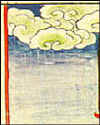|
|
|||||||||
|
Tibetan
Medicine - Tibetan
medicine - How
Maha
Kumbh
Heritage
- Ritu
Kumar - Designing
Exhibition
|
|
|
|||||||
|
the-south-asian.com January 2001 |
|||||||||
|
Page 1 of 4
BASIS OF TIBETAN MEDICINE by
All material, which makes up our universe, is based on the qualities of 5 basic elements, which are described in the ancient physics depicted in Tibetan medicine. Tibetans, as all traditional people, lived in direct contact with the natural environment. They understood through experience and study that the forces manifest in the natural environment directly correlated with and influenced the functioning of the human organism. In the theory of the five elements we see an effort to define the qualities of the basic forces that exist in nature. Once defined they are named for their most identifiable manifestations: earth, water, fire, wind and space. The characteristics (such as a substance's taste) and therefore the nature of all matter, then result from the qualities of these elements individually or in combination. THE 5 ELEMENTS IN TIBETAN MEDICINE
Combinations of these qualities make up the physical aspect of our bodies as well as its distinct physiological energies.
THREE ENERGIES THAT CONTROL & SUSTAIN BODY'S FUNCTIONS As with any medical system, understanding the various functions of the body is essential in Tibetan medicine. However, the underlying physiological principles, which create and maintain those functions, are of primary importance. Tibetan medicine defines three main systems which control the body's processes. These three systems are created at various stages of development in the womb by an interaction of our mind's developmental process and the 5 physical elements. Embryologically, the mind acts as the basis for the creation of each individual's 3 principle physical systems: translated in English as Wind, Bile, and Phlegm. These three systems create and sustain all the body's functions.
A disturbance in one, or a combination of these three principle systems results in illness. The disturbance can come from diet, behavior or environmental factors whose qualities, based on their constituent elements, act to disturb the qualities of any of the three energies. The manner in which these factors can result in illness will be more or less complex depending on the acute or chronic nature of the problem. All illnesses must be seen as individual and based on the situation of the particular patient's background. __________________ H.H. The Dalai Lama on Tibetan medicine - Tibetan medicine - How and Why it works
|
|||||||||
| Copyright © 2000 [the-south-asian.com]. Intellectual Property. All rights reserved. | |||||||||
| Home |



